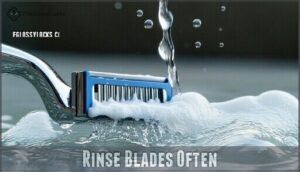This site is supported by our readers. We may earn a commission, at no cost to you, if you purchase through links.
 First, splash warm water on your face to soften hair and open pores.
First, splash warm water on your face to soften hair and open pores.
Apply a quarter-size amount of shaving cream to your palm or shaving brush. Work it into a rich lather using circular motions across your skin.
This technique helps lift hair follicles and creates a protective barrier between your razor and skin. Let the cream sit for about thirty seconds to fully soften stubble.
The key is even coverage – think of it as painting your face with protection. Don’t rush this step, as proper preparation makes all the difference.
But there’s more to achieving that perfect shave than just cream application.
Table Of Contents
- Key Takeaways
- How to Apply Shaving Cream for Smooth Skin?
- Wet Shaving Area
- Use a Shaving Brush
- Apply a Small Amount of Cream
- Lather in Circular Motions
- Leave on for a Few Minutes
- Check for Dull Blades
- Shave With Light, Gentle Strokes
- Rinse Blades Often
- Shave in The Direction of Hair Growth
- Use Precision Trimmer for Edges
- Frequently Asked Questions (FAQs)
- How do you shave your neck without getting razor bumps?
- Can you exfoliate and shave on the same day?
- How do you shave properly?
- Does shaving cream make your skin smoother?
- How do you get smooth skin when shaving?
- How to correctly apply shaving cream?
- Do you put shaving cream on wet or dry skin?
- Can I apply shaving cream on dry skin?
- How often should I replace my shaving brush?
- Is it necessary to use pre-shave oil?
- Conclusion
Key Takeaways
- Prep your skin properly – Splash warm water on your face for 2-3 minutes to soften hair follicles and open pores before applying any cream.
- Use the right amount and technique – Apply an almond-sized portion of shaving cream using circular motions with a brush or your fingers to create a rich, even lather.
- Let it work before shaving – Allow the cream to sit for 30 seconds to 2-3 minutes to fully soften stubble and maximize lubrication benefits.
- Shave with the grain using light pressure – Follow your hair’s natural growth direction with gentle strokes, rinsing your blade frequently to prevent clogging and irritation.
How to Apply Shaving Cream for Smooth Skin?
Perfect shaving cream application transforms your routine from a chore into a smooth experience. Start with warm water to soften hair follicles and open pores. Cream ingredients matter—look for moisturizing elements like aloe vera or shea butter, especially if you have skin sensitivity.
Apply a small amount using application techniques that work: either with a shaving brush for rich lather or your fingers in circular motions. This gentle exfoliation distributes cream evenly across your skin. One key is to confirm you’re hydrating and softening skin before you even begin.
Perfect application technique transforms your routine into a smooth experience.
Let it sit for 2-3 minutes—this waiting period maximizes shaving cream benefits by further softening stubborn hairs. For those with sensitive skin, consider alternative products like hair conditioner or specialized gels.
After shaving with light strokes, finish with a post-shave balm to lock in moisture and prevent irritation. These shaving cream techniques guarantee consistently smooth skin results.
Wet Shaving Area
Getting your skin properly prepped makes all the difference between a rough shave and smooth skin that feels amazing.
Water temperature plays a starring role here – you’ll want warm (not hot) water to work its magic on your facial hair.
Soak the shaving area for 2-3 minutes with warm water.
This softening hair process transforms stubborn whiskers into manageable strands while helping to open pores.
Think of it like softening butter before spreading – everything just works better.
For enhanced skin hydration, especially if you’re dealing with sensitive skin, try the warm towel trick.
Dampen a clean towel with warm water and hold it against your face for about a minute.
This towel usage technique takes wet shaving preparation to the next level.
For ideal results, consider exfoliating beforehand to remove dead skin cells.
Here’s what proper shaving preparation delivers:
- Your razor glides effortlessly instead of tugging and pulling
- Reduced risk of nicks, cuts, and that dreaded razor burn
- Smoother results that last longer throughout your day
This foundation sets you up perfectly for shaving cream application success.
Use a Shaving Brush
Now that your shaving area is properly prepared, grab a quality shaving brush to transform your routine. Think of it as your secret weapon for achieving that perfect lather every time.
Brush material types matter more than you’d expect. Badger hair brushes offer superior water retention and create luxurious lather, while boar bristles provide firmer exfoliation benefits. Synthetic options deliver consistent performance without the premium price tag.
Your brush choice transforms ordinary cream into luxurious, skin-protecting lather.
Master proper lathering techniques by wetting your brush with warm water, shaking off excess, then swirling it into your shaving cream. Use circular motions to build rich foam while gently lifting facial hair away from skin. This method guarantees better cream absorption and prepares hair for a closer cut. The brush also softens skin effectively by applying warm water and shaving cream, enhancing moisture absorption.
Your shaving cream application methods improve dramatically with a brush. The bristles exfoliate dead skin cells while distributing product evenly across your face.
Brush maintenance keeps your investment working properly:
- Rinse thoroughly after each use to remove soap residue
- Hang bristles-down to prevent water damage to the handle
- Store in a dry, ventilated area between uses
Proper care extends your brush’s lifespan while guaranteeing consistently smooth skin results.
Apply a Small Amount of Cream
With your brush ready, you’ll need just the right cream amount for perfect results. Think of it like seasoning a dish – too little won’t do the job, too much creates waste. An almond-sized portion covers your entire face perfectly.
This measured approach guarantees economical usage while delivering even distribution across your skin. Quality shaving cream expands substantially when lathered, so resist the urge to squeeze out more. Your wallet will thank you later.
Brush application beats fingers every time for consistent coverage. The bristles work the cream into every contour, creating that rich lather you’re after. Meanwhile, fingers often leave patchy spots that lead to nicks and irritation. To achieve this, soaking skin beforehand is a helpful preparation step.
Storage tips matter too. Keep your shaving cream in a cool, dry place to maintain proper consistency. Heat and humidity break down the formula, making it less effective. A bathroom cabinet works better than leaving it on your shower shelf.
Remember, mastering shaving cream application methods starts with getting the amount right first.
Lather in Circular Motions
After applying your shaving cream, work it into a rich lather using gentle circular motions. This Circular Technique isn’t just busy work—it’s the foundation of smooth skin and effective Cream Distribution. Your fingertips become the perfect tools for creating that luxurious foam that transforms your shaving experience.
Circular motions provide multiple Exfoliation Benefits while building Lather Quality. The massage action lifts facial hair away from your skin, making each stroke more effective. This Skin Stimulation also increases blood flow, preparing your face for what’s coming next.
Here’s what proper circular lathering accomplishes:
- Softens tough facial hair for easier cutting
- Removes dead skin cells that could clog your razor
- Creates uniform coverage across your entire shaving area
- Stimulates circulation for healthier-looking skin
Focus on maintaining consistent pressure—firm enough to work the shaving cream but gentle enough to avoid irritation. Many find that using castile bar soap offers a nourishing lather without harsh chemicals. Spend 30-60 seconds massaging in small circles, ensuring every area gets attention. You’ll notice the cream transforming into that perfect protective barrier.
Leave on for a Few Minutes
After working up that perfect lather, resist the urge to start shaving immediately. Your shaving cream needs time to work its magic on your skin and hair.
This waiting period allows for maximum cream absorption and skin softening, setting you up for the smoothest shave possible. During these few minutes, the cream’s moisturizing ingredients penetrate deeper into your skin while simultaneously providing hair follicle hydration.
This process softens even the most stubborn whiskers and helps them stand upright, making them easier to slice through cleanly. Think of it as marinating your face—the longer you wait, the better the results.
The enhanced lubrication from proper cream absorption creates a protective barrier between your razor and skin. This pre-shave benefit substantially reduces friction, minimizing your chances of razor burn or nicks.
To further minimize razor burn, remember to exfoliate skin beforehand. Use this time productively—brush your teeth, pick out clothes, or simply relax.
These shaving cream application techniques might add a few minutes to your routine, but they’re game-changers for achieving smooth skin. Your patience pays off with a comfortable, irritation-free shave that leaves your skin feeling fantastic.
Check for Dull Blades
Once your shaving cream has had time to work its magic, blade sharpness becomes your next priority. Your safety razor blades typically last 4-5 shaves before requiring replacement, though this varies based on your shaving frequency and hair thickness.
Watch for these sharpness indicators: if your razor tugs or pulls at hair instead of cutting cleanly, you’re dealing with a dull blade. Metal deterioration and chipping occur naturally with use, reducing efficiency by approximately 50% after the first few shaves.
Test blade sharpness by gently drawing it across your fingernail—sharp blades glide smoothly while dull ones catch or skip. Irritation signs like increased razor burn, nicks, or inconsistent cutting performance signal it’s time for blade replacement.
Proper blade maintenance extends lifespan: rinse thoroughly after each use, store in dry conditions, and consider blade oil for lubrication. To further extend blade life, consider protective coatings application. Remember, use a designated sharps container when disposing of old blades for safety.
Shave With Light, Gentle Strokes
Most shaving mishaps happen when you rush through the process with heavy-handed pressure. The secret to achieving smooth skin lies in treating your razor like a precision instrument rather than a bulldozer.
Your blade angle matters tremendously for ideal results. Hold the razor at approximately 30 degrees against your skin, allowing the blade’s weight to guide each stroke. This technique minimizes pressure and irritation while maximizing effectiveness. Proper skin stretching impact can’t be overstated—gently pull the skin taut with your free hand to create an even surface.
Master these essential shaving techniques for consistently smooth results:
- Use short, controlled strokes instead of long sweeping motions for better stroke length control
- Apply minimal pressure—let the sharp blade do the work naturally
- Avoid multiple pass risks by getting it right the first time
- Focus on one small section at a time for precision
Remember, your shaving cream provides the lubrication needed for gentle gliding, so trust the process and resist pressing harder. To maintain hygiene, sanitize your razor regularly.
Rinse Blades Often
A dirty razor blade cuts through hair like trying to slice a tomato with a butter knife covered in peanut butter. That’s why rinsing blades often during your shave is essential for maintaining blade sharpness and achieving smooth skin.
After every two to three strokes, hold your razor under warm running water. This simple step will prevent clogging by washing away accumulated shaving cream, hair, and dead skin cells. A clean blade maintains better visibility of your progress and delivers more effective cuts.
Hygiene practices like frequent rinsing also reduce irritation. When debris builds up, your razor drags rather than glides, increasing friction and potential nicks. Think of it as clearing snow from your windshield – you wouldn’t drive with an obstructed view.
For thick or coarse hair, rinse even more frequently. The payoff? A smooth shave with fewer passes needed. To further extend the life of your blades, consider sterilizing with alcohol to prevent bacteria. These shaving techniques and shaving tips transform your routine from a chore into an efficient grooming experience.
Shave in The Direction of Hair Growth
The secret to achieving smooth skin lies in respecting your hair’s natural roadmap. When you shave in the direction of hair growth, you’ll minimize irritation by up to 50% compared to going against the grain.
This simple technique prevents ingrowns and keeps your skin happy. Start by mapping your hair growth patterns—they’re different across your face and body.
Run your hand over the area to feel which way the hair naturally lies. On your face, this typically means downward strokes on cheeks and upward on your neck.
Maintain a 30-degree blade angle with gentle pressure as you follow these natural pathways. Your shaving cream provides the perfect glide when combined with proper shaving direction.
Light, controlled strokes work best—think of it as guiding the razor, not forcing it. For an even closer shave, consider using J-shaped movements for precise results.
This approach reduces razor burn and delivers the smooth results you’re after while keeping your skin comfortable. By following these steps, you can achieve the skin you desire with minimal irritation, making the shaving process more enjoyable and stress-free.
Use Precision Trimmer for Edges
Once you’ve mastered shaving with the grain, precision trimmers become your secret weapon for edge work. These specialized tools excel at curved surface trimming and detailing techniques that regular razors can’t handle.
Apply a thin layer of shaving cream to areas needing attention – sideburns, mustache lines, and beard edges. Your precision trimmer works best on slightly damp skin with proper lubrication for a smooth shave.
Consider the importance of motor quality for smooth trimming when selecting a T-blade trimmer. Use trimmer attachments designed for different angles and lengths.
Work in small sections with steady, controlled movements. Stretch skin taut with your free hand for better control around shaving edges.
Trimmer maintenance matters – clean blades after each use and monitor battery life to avoid mid-shave power loss. Replace dull blades promptly for peak performance.
Take your time with detailed work. Rushing leads to uneven lines and potential nicks. Master these detailing techniques, and you’ll achieve professional-looking results every time.
Frequently Asked Questions (FAQs)
How do you shave your neck without getting razor bumps?
About 70% of men experience razor bumps on their neck due to curved hair follicles.
Shave with the grain, use light pressure, stretch skin taut, and rinse your blade frequently to prevent irritation.
Can you exfoliate and shave on the same day?
Yes, you can exfoliate and shave on the same day.
Exfoliate before shaving to remove dead skin cells and improve razor efficiency.
This combination actually enhances your shave by creating smoother skin and preventing ingrown hairs.
How do you shave properly?
Perfect shaving isn’t rocket science, but it’ll transform your skin from sandpaper to silk.
Prep with warm water, apply cream, shave with the grain using light strokes, rinse your razor frequently.
Finish with cool water to close pores, which is a crucial step to achieve silky skin.
Does shaving cream make your skin smoother?
Shaving cream creates a protective barrier that reduces friction between your razor and skin, preventing irritation and razor burn.
It also softens hair follicles, making them easier to cut cleanly for smoother results.
How do you get smooth skin when shaving?
Prep your skin with warm water for 2-3 minutes, apply quality shaving cream in circular motions, shave with the grain using light strokes, and finish with cool water and moisturizer.
How to correctly apply shaving cream?
Apply a small, almond-sized amount using circular motions to create rich lather.
Wet your brush with warm water first, then swirl into cream for better coverage and gentle exfoliation than finger application.
Do you put shaving cream on wet or dry skin?
You’ll want to apply shaving cream on wet skin that’s been soaked in warm water for 2-3 minutes. This softens hair and opens pores for smoother application.
Can I apply shaving cream on dry skin?
Definitely don’t do dry application – you’ll drag and damage delicate skin.
Always wet your skin with warm water first, then apply cream.
Dry application creates friction, increases irritation, and won’t give you that smooth shave you’re after.
How often should I replace my shaving brush?
Replace your shaving brush every 6-12 months with daily use, or when bristles start shedding excessively, losing shape, or developing an unpleasant odor that won’t wash out.
Is it necessary to use pre-shave oil?
While many shavers swear by pre-shave oil, it’s not essential for everyone.
If you have sensitive skin or coarse hair, it creates an extra protective barrier and softens whiskers for smoother gliding.
Conclusion
Mastering how to apply shaving cream for smooth skin transforms your daily routine from a rushed chore into a comfortable ritual.
You’ve learned the essential steps: wet preparation, proper lathering technique, and strategic application.
Remember that quality shaving cream creates a protective barrier while lifting hair follicles for easier cutting.
Don’t forget to replace dull blades regularly and maintain gentle pressure throughout your shave.
With consistent practice, you’ll achieve that barbershop-quality smoothness at home.
- https://www.mayoclinic.org/healthy-lifestyle/adult-health/in-depth/skin-care/art-20048237
- https://www.researchgate.net/publication/221983456_Insights_into_shaving_and_its_impact_on_skin
- https://pubmed.ncbi.nlm.nih.gov/26165590/
- https://www.scribd.com/document/788672858/Shaving-Cream
- https://www.pinnacleblooms.org/ma/shaving-foam-therapy











